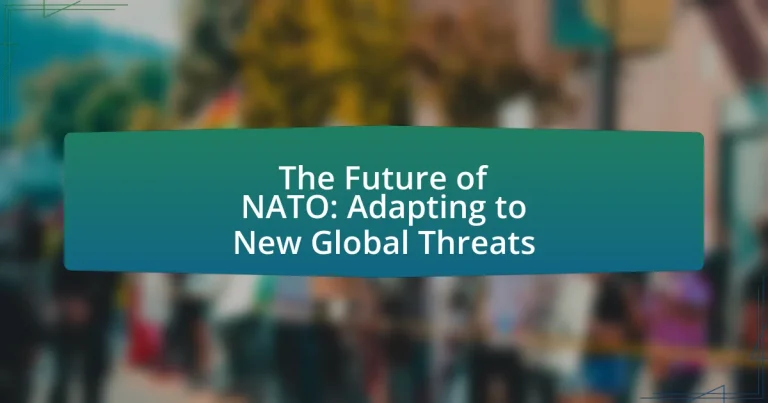The article focuses on NATO and its ongoing adaptation to new global threats, emphasizing the challenges it currently faces, including geopolitical tensions, military readiness, and internal cohesion. It explores how emerging threats such as cyber warfare and terrorism impact NATO’s mission and necessitate strategic changes. The discussion includes NATO’s Enhanced Forward Presence, collective defense principles, and partnerships with non-member countries, highlighting the importance of adaptability in maintaining security. Additionally, the article examines historical precedents, potential conflicts arising from NATO’s strategic changes, and practical steps for enhancing crisis response and future readiness.

What are the current challenges facing NATO?
NATO currently faces several significant challenges, including geopolitical tensions, military readiness, and internal cohesion. Geopolitical tensions are primarily driven by Russia’s aggressive actions, such as the annexation of Crimea in 2014 and ongoing military activities near NATO borders, which have heightened security concerns among member states. Military readiness is another challenge, as NATO must ensure that its forces are adequately equipped and prepared to respond to various threats, including cyber warfare and terrorism. Additionally, internal cohesion is tested by differing priorities and defense spending levels among member countries, which can lead to friction in collective decision-making. These challenges necessitate a strategic reassessment of NATO’s role and capabilities in a rapidly changing global landscape.
How do emerging global threats impact NATO’s mission?
Emerging global threats significantly impact NATO’s mission by necessitating a shift in strategic focus and operational readiness. As threats such as cyber warfare, terrorism, and geopolitical tensions evolve, NATO must adapt its defense strategies to address these challenges effectively. For instance, the rise of cyber attacks has led NATO to enhance its cyber defense capabilities, recognizing that traditional military responses may not suffice. Additionally, the 2010 Strategic Concept emphasized the need for collective defense against non-traditional threats, illustrating NATO’s commitment to evolving its mission in response to changing global dynamics. This adaptability is crucial for maintaining security and stability in the face of increasingly complex threats.
What types of global threats are most concerning for NATO?
The types of global threats most concerning for NATO include cyber threats, terrorism, and the resurgence of state-based military aggression. Cyber threats have become increasingly sophisticated, with state and non-state actors targeting critical infrastructure and sensitive information, as evidenced by incidents like the 2020 SolarWinds attack. Terrorism remains a persistent challenge, with groups like ISIS and Al-Qaeda continuing to pose risks to member states. Additionally, the resurgence of state-based military aggression, particularly from Russia and China, has raised alarms, highlighted by Russia’s annexation of Crimea in 2014 and ongoing military activities in Eastern Europe and the South China Sea. These threats necessitate NATO’s adaptation and response strategies to ensure collective security.
How does cyber warfare challenge NATO’s defense strategies?
Cyber warfare significantly challenges NATO’s defense strategies by undermining traditional military deterrence and complicating collective defense mechanisms. The rise of cyber threats allows adversaries to conduct operations that can disrupt critical infrastructure, steal sensitive information, and influence public opinion without the need for conventional military engagement. For instance, the 2007 cyber attacks on Estonia demonstrated how a coordinated cyber assault could paralyze a nation’s digital infrastructure, raising concerns about NATO’s ability to respond effectively under Article 5, which mandates collective defense. Additionally, the anonymity of cyber attackers complicates attribution, making it difficult for NATO to identify and respond to threats decisively. This evolving landscape necessitates that NATO adapt its strategies to incorporate cyber defense as a core component of its overall security framework.
Why is NATO’s adaptability crucial in today’s geopolitical landscape?
NATO’s adaptability is crucial in today’s geopolitical landscape because it enables the alliance to respond effectively to evolving security threats. The current global environment is characterized by diverse challenges, including cyber warfare, terrorism, and geopolitical tensions, which require a flexible and responsive military strategy. For instance, NATO’s Enhanced Forward Presence in Eastern Europe demonstrates its ability to deter aggression from state actors, while initiatives like the NATO Cyber Defence Centre of Excellence address the growing threat of cyber attacks. This adaptability ensures that NATO remains relevant and capable of protecting its member states in an increasingly complex security landscape.
What historical precedents demonstrate NATO’s adaptability?
NATO’s adaptability is demonstrated through its response to the end of the Cold War, the 9/11 terrorist attacks, and the ongoing challenges posed by cyber threats. Following the Cold War, NATO transitioned from a purely defensive alliance focused on countering the Soviet Union to engaging in crisis management and cooperative security, exemplified by its involvement in the Balkans during the 1990s. After the 9/11 attacks, NATO invoked Article 5 for the first time, leading to collective military action in Afghanistan, which showcased its ability to address non-traditional security threats. More recently, NATO has adapted to cyber threats by establishing the Cyber Operations Centre in 2017, emphasizing its commitment to evolving security challenges. These historical precedents illustrate NATO’s capacity to modify its strategic focus and operational capabilities in response to changing global dynamics.
How can NATO learn from past conflicts to address future threats?
NATO can learn from past conflicts by analyzing historical military engagements and adapting its strategies accordingly to address future threats. For instance, the lessons learned from the conflicts in Afghanistan and Iraq highlight the importance of understanding local dynamics and the need for comprehensive approaches that include political, economic, and social dimensions alongside military action. Additionally, the NATO-led intervention in Libya in 2011 demonstrated the necessity of clear objectives and exit strategies to avoid prolonged engagements. By incorporating these insights into its planning and operations, NATO can enhance its readiness and effectiveness in responding to emerging global threats, such as cyber warfare and hybrid tactics employed by state and non-state actors.

How is NATO evolving to meet new security demands?
NATO is evolving to meet new security demands by enhancing its collective defense posture and increasing its focus on emerging threats such as cyber warfare and hybrid warfare. The alliance has implemented the Enhanced Forward Presence in Eastern Europe, which includes multinational battlegroups in countries like Poland and the Baltic states, to deter aggression from adversaries. Additionally, NATO has established a Cyber Operations Center and is prioritizing the integration of cyber defense into its overall strategy, reflecting the growing importance of cybersecurity in modern conflicts. These adaptations are supported by the 2014 Wales Summit commitments, where member states agreed to increase defense spending and improve readiness, demonstrating NATO’s proactive approach to evolving security challenges.
What strategic initiatives are being implemented by NATO?
NATO is implementing several strategic initiatives to adapt to new global threats, including the Enhanced Forward Presence, the NATO Readiness Initiative, and the Defense and Deterrence Posture. The Enhanced Forward Presence involves deploying multinational battlegroups in Eastern Europe to deter aggression, particularly from Russia. The NATO Readiness Initiative aims to ensure that 300,000 troops are ready to deploy within 30 days or less in response to crises. Additionally, the Defense and Deterrence Posture focuses on strengthening collective defense through increased military exercises and improved interoperability among member states. These initiatives reflect NATO’s commitment to addressing evolving security challenges and maintaining stability in the Euro-Atlantic area.
How does NATO’s Enhanced Forward Presence strengthen deterrence?
NATO’s Enhanced Forward Presence strengthens deterrence by positioning multinational battlegroups in Eastern Europe, which enhances collective defense capabilities. This forward deployment demonstrates NATO’s commitment to Article 5 of the Washington Treaty, signaling to potential aggressors that any attack on a member state will trigger a collective response. The presence of approximately 4,500 troops from various NATO countries in countries like Estonia, Latvia, Lithuania, and Poland serves as a visible deterrent, reinforcing the alliance’s readiness and resolve. This strategic positioning is further supported by military exercises and enhanced interoperability among member forces, which collectively deter aggression by showcasing NATO’s operational capabilities and unity.
What role does collective defense play in NATO’s strategy?
Collective defense is a cornerstone of NATO’s strategy, primarily embodied in Article 5 of the North Atlantic Treaty, which asserts that an armed attack against one member is considered an attack against all. This principle serves to deter potential aggressors by ensuring that any attack on a NATO member will trigger a collective military response, thereby enhancing the security of all member states. Historical instances, such as the invocation of Article 5 after the September 11 attacks in 2001, demonstrate its critical role in unifying member nations against common threats and reinforcing the alliance’s commitment to mutual defense.
How is NATO enhancing its partnerships with non-member countries?
NATO is enhancing its partnerships with non-member countries through initiatives such as the Partnership for Peace program, which facilitates military cooperation and interoperability. This program allows non-member nations to engage in joint exercises, training, and planning with NATO forces, thereby strengthening defense capabilities and fostering regional stability. Additionally, NATO has established tailored partnerships with countries like Sweden and Finland, focusing on specific security challenges and collaborative defense strategies. These efforts are supported by the NATO 2030 agenda, which emphasizes the importance of global partnerships in addressing emerging threats, such as cyber warfare and terrorism, thereby reinforcing NATO’s collective security framework.
What benefits do partnerships bring to NATO’s operational capabilities?
Partnerships enhance NATO’s operational capabilities by providing access to a broader range of resources, expertise, and strategic perspectives. These collaborations enable NATO to conduct joint exercises and operations, improving interoperability among member and partner nations. For instance, NATO’s Enhanced Forward Presence in Eastern Europe demonstrates how partnerships with countries like Sweden and Finland bolster collective defense efforts against potential threats. Additionally, partnerships facilitate intelligence sharing and logistical support, which are crucial for effective crisis response and mission success.
How does NATO collaborate with organizations like the EU and UN?
NATO collaborates with organizations like the EU and UN through strategic partnerships and joint initiatives aimed at enhancing security and addressing global threats. This collaboration includes regular consultations, joint military exercises, and coordinated responses to crises, exemplified by NATO’s involvement in EU-led missions and UN peacekeeping operations. For instance, NATO and the EU have established a framework for cooperation that includes sharing intelligence and resources, which has been crucial in addressing challenges such as terrorism and cyber threats. Additionally, NATO’s support for UN peacekeeping missions demonstrates its commitment to global stability, as seen in operations where NATO forces have provided logistical and operational support to UN missions in conflict zones.
What are the implications of NATO’s future direction?
NATO’s future direction implies a shift towards enhanced collective defense and increased focus on emerging global threats, such as cyber warfare and hybrid conflicts. This evolution is driven by the need to address security challenges posed by state and non-state actors, as evidenced by Russia’s actions in Ukraine and the rise of terrorism. NATO’s commitment to Article 5, which emphasizes collective defense, remains central, but the alliance is also adapting its strategies to incorporate new technologies and intelligence-sharing mechanisms. The 2022 NATO Strategic Concept outlines these priorities, highlighting the importance of deterrence and defense in response to evolving threats.
How will NATO’s evolution affect global security dynamics?
NATO’s evolution will significantly enhance global security dynamics by adapting to emerging threats and fostering collective defense among member states. As geopolitical tensions rise, NATO has expanded its focus beyond traditional military threats to include cyber warfare, terrorism, and hybrid warfare tactics. For instance, NATO’s Enhanced Forward Presence in Eastern Europe demonstrates its commitment to deterring aggression from adversaries like Russia, thereby stabilizing the region. Additionally, NATO’s partnerships with non-member countries and international organizations, such as the European Union, strengthen global security cooperation and intelligence sharing. This evolution reflects a proactive approach to security, ensuring that NATO remains relevant in addressing contemporary challenges and maintaining peace in a multipolar world.
What potential conflicts could arise from NATO’s strategic changes?
NATO’s strategic changes could lead to increased tensions with Russia, as the alliance’s expansion and military enhancements may be perceived as direct threats. Historical context shows that NATO’s eastward expansion since the 1990s has already contributed to heightened hostilities, exemplified by Russia’s annexation of Crimea in 2014. Additionally, NATO’s focus on collective defense in response to emerging threats could provoke regional conflicts, particularly in Eastern Europe and the Balkans, where historical grievances and ethnic tensions remain unresolved. These dynamics suggest that NATO’s evolving strategies may inadvertently escalate military confrontations and geopolitical rivalries.
How might NATO’s future decisions influence member states’ defense policies?
NATO’s future decisions will likely lead member states to adjust their defense policies to align with collective security strategies and emerging threats. For instance, if NATO prioritizes cyber defense in response to increasing cyberattacks, member states may allocate more resources to enhance their cybersecurity capabilities. Historical examples include the 2010 NATO Strategic Concept, which prompted members to increase defense spending and modernize their forces in response to evolving security challenges. Additionally, NATO’s commitment to collective defense, as outlined in Article 5, reinforces the necessity for member states to ensure their military readiness, thereby influencing national defense budgets and strategic planning.
What practical steps can NATO take to ensure effective adaptation?
NATO can ensure effective adaptation by enhancing its rapid response capabilities and increasing investment in emerging technologies. By establishing a streamlined command structure, NATO can improve decision-making speed during crises, as evidenced by the successful deployment of the NATO Response Force in recent conflicts. Additionally, prioritizing research and development in areas such as cyber defense and artificial intelligence will enable NATO to counter new threats effectively, reflecting the alliance’s commitment to maintaining strategic superiority in a rapidly changing security environment.
How can NATO improve its crisis response mechanisms?
NATO can improve its crisis response mechanisms by enhancing interoperability among member states and investing in rapid deployment capabilities. Interoperability ensures that forces from different nations can work seamlessly together during crises, which is crucial for effective response. For instance, NATO’s Enhanced Forward Presence has demonstrated the importance of joint exercises and training to build cohesive operational capabilities. Additionally, increasing funding for rapid response units, such as the NATO Response Force, allows for quicker mobilization and deployment in emergencies, as evidenced by the swift actions taken during the 2014 Ukraine crisis. These strategies collectively strengthen NATO’s ability to address emerging global threats effectively.
What best practices should NATO adopt for future readiness?
NATO should adopt enhanced interoperability and rapid response capabilities as best practices for future readiness. Enhanced interoperability among member nations ensures that forces can operate seamlessly together, which is critical in addressing diverse threats. For instance, NATO’s recent exercises, such as Trident Juncture 2018, demonstrated the importance of joint operations, involving over 50,000 troops from 31 nations, highlighting the need for cohesive action in crisis situations. Additionally, investing in advanced technologies, such as artificial intelligence and cyber defense, will bolster NATO’s ability to respond swiftly to emerging threats, as evidenced by the increasing frequency of cyberattacks on member states. By focusing on these practices, NATO can maintain its strategic advantage in a rapidly evolving security landscape.




